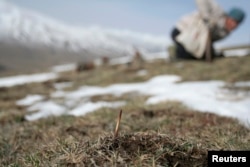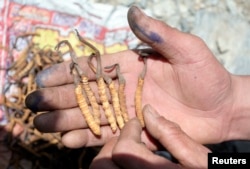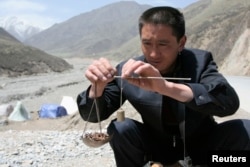In high-alpine meadows of the Tibetan Plateau, early May is an auspicious time to prostrate oneself on the loamy, reclining slopes and dig around for desiccated remnants of a medicinally hallowed caterpillar fungus.
Revered as the "Viagra of the Himalayas," Cordyceps Sinensis is better known across Asia by its traditional Tibetan name, yartsa gunbu, which literally translates as "summer grass, winter worm." Neither grass nor worm, the coveted delicacy—blended in health drinks or sprinkled over entrees in China’s swankest restaurants—is the fungal bloom of mummified Ghost Moth larvae. Fetching thousands of dollars per pound, its storied powers as a medicinal cure-all have been overshadowed only by its more marketable reputation as a high-octane aphrodisiac, the result of commercial initiatives that have enriched many of Tibet's struggling nomadic pastoralists.
That's why a handful of noted research scientists wonder why there’s been such little scrutiny of the research backing a public health warning from China’s State Food and Drug Administration (CFDA). Citing unsafe levels of cancer-causing arsenic in the fungus, the February 2016 announcement triggered a moratorium on pilot programs designed to expand the organism’s commercial development and distribution. While scientists question the research supporting the decision, some free Tibet advocates say science has nothing to do with it.
Tracing Source of Elevated Arsenic
As the Himalayan winter sets in, parasitic fungi nestled in tundra some 3,000-5,000 meters above sea level begin preying upon burrowing caterpillars, consuming their innards before sending a slim horn up through the dead insect's head. The matchstick-thin protuberances—difficult to spot in the springtime scrub-grass and weeds—often require the sharp-eyed vision of young children, whose schools typically close to accommodate families that depend upon the harvest.
"Cordyceps are considered one of the most valuable medicines in Chinese medicine, historically,” says Professor Karl Tsim of Hong Kong University of Science and Technology, explaining that the rare fungus allegedly boosts the immune system, restores youthfulness, improves sexual vigor and even treats some forms of cancer. Records of its health benefits can be traced for nearly 1,000 years, which is why Tsim decided to investigate soil samples from several Tibetan harvesting grounds.
Commissioned with funding from government officials in Hong Kong—a thriving market for the fungus—Tsim’s study began when CFDA officials doubled down on their public health warning, announcing plans to end a yartsa gunbu pilot program launched in August 2012. According to state-run Xinhua news, the five-year pilot program had permitted several large pharmaceutical companies to use yartsa gunbu as a raw ingredient in a range of health food products. If the programs had become permanent, harvest contracts likely would have provided a windfall for people in the Tibetan areas where yartsa gunbu is already a backbone of the rural economy.
What Tsim's team found, however, produced more questions than answers. While arsenic levels in three Tibetan soil samples were slightly higher than those found near Hong Kong, preliminary results show no indication that resulting crops could be contaminated.
Normal levels
Naturally present in the earth’s crust, trace concentrations of arsenic are commonly found in staples such as brown rice. However, a 2012 joint working document of the U.N.’s Food and Agriculture and World Health organizations indicates that rice-paddy irrigation practices, not soil contamination, were the culprit.
"As a result of naturally occurring metabolic processes in the biosphere, arsenic occurs in a large number of organic or inorganic chemical forms in food," the documents says, adding that “analysis of total arsenic in food has up to date suffered from difficulties with respect to accuracy and precision."
“Available data about the possible human exposure to inorganic arsenic … suggest that the [permissible human weekly exposure] will normally not be exceeded, unless there is a large contribution from drinking water,” it says.
Because arsenic-concentration levels fluctuate across different harvesting grounds, Tsim says trace amounts of the substance are to be expected, and that his soil samples reveal no indication of inorganic contaminants, let alone grounds for a public health warning. Furthermore, alpine meadows—exposed only to rainwater and, sometimes, glacial runoff—aren’t irrigated. Indeed, the only quantitatively provable threat to public health would be if the fungus, which is literally worth its weight in gold, were consumed in unreasonably large quantities.
"Nobody can eat 100 grams at one time," let alone afford that type of routine diet, he said. "If we look at numbers, whatever arsenic that we intake for a certain period of time is very minimal.”
Dr. Michelle Stewart, an Amherst College-based conservationist who conducted field research on Tibetan yartsa gunbu production, says although traces of arsenic in various individual caterpillar fungi “could be possible,” cases are typically isolated.
“I wouldn’t call it grounds to issue an alarmist reaction to caterpillar fungus broadly,” she told VOA. But a sustainable and financially vibrant yartsa gunbu industry could, she added, impede some of Beijing’s long-term regional development strategies.
“China’s idealized development model [for Tibet] would probably be based on settling nomadic populations in urban areas and transitioning their livelihoods into, if possible, non-skilled labor positions in towns or small-scale businesses,” Stewart said. “But the caterpillar fungus economy has actually been able to allow Tibetans to stay in their pastoral livelihoods and make money.”
For staunch critics of China's Tibet policy, the sudden cancellation of pilot programs smacks of economic hegemony.
“The Chinese are the colonizers in Tibet,” said Lhukar Jam, a Dharmsala-based advocate of self-rule who recently ran for head of Tibet’s exiled government.
“The colonizers don’t want their subjects to become politically, economically and culturally ... equal to them,” he said, accusing Beijing of conspiring to undermine Tibet's growing middle class. “The Chinese government fundamentally feels threatened when they see people on the Tibetan Plateau gain power through the economy. They don’t want to have genuine economic development in Tibet.”
Kalsang Gyaltsen Bapa, a China analyst and member of the Tibetan parliament-in-exile, also cites a relationship between stable livelihoods and political activism in some Tibetan communities.
“The Chinese government uses the economy to gain people’s obedience, which has achieved some success,” Bapa told VOA, calling Tibetans who are financially dependent upon Beijing's sustained rule—government employees or retired people, for example—“politically paralyzed.”
Financially independent Tibetans, he added, are more likely to think independently, and therefore support movements for a return to self-governance.
Over the course of three months, at least four email requests and phone calls seeking CFDA commentary on the public health warning, and response to its subsequent criticism, went unanswered.
Pattern of controlled development
Ever since Ex-Premier Jiang Zemin’s “Great Western Development” policies, China has expanded efforts to lure Tibetan farmers and nomads into new housing developments with a combination of subsidies and interest-free loans. Coupled with high-tech rail and infrastructural development campaigns designed to create a widespread middle class by 2020, none of Beijing’s grand economic strategies have supplanted the tiny parasitic worm’s power to elevate the average Tibetan household.
According to one yartsa gunbu dealer who asked to remain anonymous, a family with good harvesters stand to make as much as 1,000,000 yuan (about $150,000) within the two month harvest window. One tangible sign of the economic progress is visible on the roads. In 2014, Xinhua reported that the Tibetan Autonomous Region had an estimated 325,000 privately owned cars—one for every 10 people in the region, with the highest concentration of ownership in yartsa gunbu harvesting hotspots.
According to chinadialogue.com, Tibet’s annual yartsa gunbu haul earns local collectors some $1 billion annually. But reports from the bi-lingual environmental publication also suggest production may well exceed what’s reported to authorities. Daniel Winkler, a Seattle-based ecologist who has done extensive research on the fungus, puts annual global yields closer to 100 to 200 tons. With 96.4 percent of global supply coming from Tibet, annual revenues may well exceed the $2 billion mark.
Anti-corruption parallels
The specter of greed and corruption inevitably shadow high-volume sales of any precious commodity. As President Xi Jinping’s anti-corruption campaign was launched, yartsa gunbu, which is often exploited to leverage “Guanxi”—the personal connections and networks in which the exchange of expensive and often exotic gifts are key to building influence in politics or business—was an easy target.
February’s CFDA announcement declaring yartsa gunbu a threat to public health occurred just as President Xi’s anti-corruption campaign gained nationwide momentum.
“The place within the Guanxi—which some people say is bribery—within that economy, the value (of yartsa gunbu) has diminished slightly in the past year,” she said.
Whether any political motivations are driving the Chinese government’s claim to public health concerns about the fungus is yet to be seen. But Professor Tsim, who continues evaluating soil samples, says any regulatory action on the fungus inevitably affects the livelihood of Tibetans. The CFDA announcement has yet to impact Hong Kong prices, he said, and one eBay seller recently posted the fungus for about $78,000 per pound.
“[For] many of those of people, their lives all depended on collection of Cordyceps,” Tsim said. “So in Tibet, many of those local people, their daily income [depends upon] the collection of Cordyceps. So I suppose that before we place that hold [on pilot projects], we need to know what we are talking about.”
VOA correspondent Yeshi Dorje reports for VOA's Tibetan Service. Pete Cobus contributed reporting.














